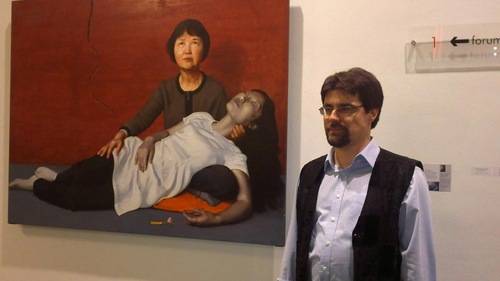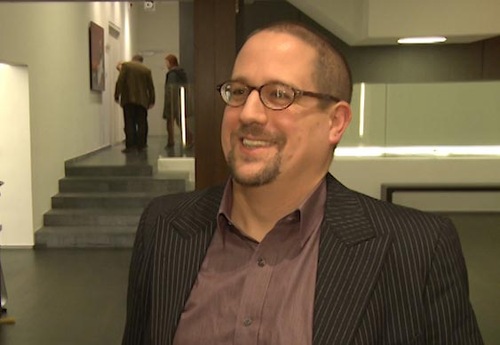(Minghui.org) Oil painting “An Unnecessary Death” by young artist Vim van Aalst won the “Painting of the Year” contest in Belgium for 2013. The contest is organized by Raoul Locht, publisher of a number of art magazines in Holland, including Atelier Magazine . The award ceremony took place on January 9, 2014 in Turnhout, Belgium at the Würth Group, the major sponsor of the contest.
Over 300 paintings were entered in the competition, and among those, 13 finalists were selected. A 13-member jury picked the final winner, and the grand prize amount was, not surprisingly, 2,013 Euros.
 Mr. Wim van Aalst and his award-winning piece “An Unnecessary Death”
Mr. Wim van Aalst and his award-winning piece “An Unnecessary Death”
“An Unnecessary Death” depicts a grief-stricken mother of a Falun Gong practitioner holding her daughter. The daughter has been killed as a result of torture in the persecution of Falun Gong. The painting exposes the brutal reality of the persecution with the subject of a loving mother's pain and loss.
Jury: Social Commitment Combined with Love for Classical Art
 Mr. Raoul Locht, organizer of the “Painting of the Year” contest and publisher of a number of art magazines in Holland including Atelier Magazine.
Mr. Raoul Locht, organizer of the “Painting of the Year” contest and publisher of a number of art magazines in Holland including Atelier Magazine.
Mr. Raoul Locht, organizer of the contest, read the jury's comments on the final winner at the award ceremony: “The theme of ‘the Pieta’ was translated masterfully by Wim van Aalst through a dramatic event from present times. The mourning mother who is holding the deceased body of her daughter, the simplicity of the composition, and the contrast of the colors and the black and white, stress the dramatic content in his work. Meanwhile you can interpret this balanced simplicity as an indirect reference to Buddhism.”
In addition to the artistic achievement of the painting, the jury also praised the combination of the painter's social commitment and love for classical art: “The title of this painting, ‘An Unnecessary Death’ refers to the Buddhist Falun Gong practice in China, a peaceful spiritual movement that is persecuted by the regime. The practitioners place importance on the values of compassion and tolerance, but their beliefs are outlawed by the Chinese government.
“Wim van Aalst succeeds in bringing together his social commitment and his love for classical art into a beautiful and powerful, touching, and nicely balanced work of art, where even the crack in the red wall carries deeper meaning. A deserved winner…”
Mr. Raoul Locht commented: “It’s a very beautiful art piece that is very realistic and carries beautiful symbolic value and has a wonderful composition. An all-round winner.”
Painting Draws Attention to the Persecution
Peter van Etten, CEO of the Würth Group, attended the award ceremony on behalf of the company, a major sponsor of the event. He thought the winner was “a true winner:” “Regarding the quality of the work, it’s a very beautiful piece. Also the composition, the colors and the theme that was chosen makes it for sure worthy to be the winner.”
Speaking of the persecution of Falun Gong, Mr. van Etten said, “I have to admit that this movement in China is not known to me. And I’m sure that for all the around 150 people who work here at Würth, this issue also is not well-known, so that’s why I think it is good that now, in this way, it is brought into the spotlight.”
Mr. Wim van Aalst practices Falun Gong. He considered this the first piece that he was truly satisfied with, as it incorporated a part of himself. He considers his winning an endorsement of realistic art and is especially pleased that his painting could help raise this very important global issue.
Reinhold Würth, founder of the Würth Group, started an art collection around the 1960s. Now this collection is among the biggest private art collections in Europe, with over 16,000 art pieces in the collection. Most pieces are from the 20 th and 21 st centuries.
The art pieces of the collection travel around between the galleries located at the different Würth locations in Europe.
Finalists of the “Painting of the Year” contest, including “An Unnecessary Death” are now on display in a dedicated gallery at the museum at Würth Belux N.V in Turnhout, Belgium.





